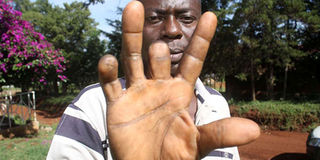Rongo locals recall years of terror as they preach peace

Rongo resident Tiberius Wesonga. He suffered the injuries during the 1997 clashes between Kisiis and Luos. PHOTO | BENSON MOMANYI | NATION MEDIA GROUP
What you need to know:
- Among the Kisii, there was Chinkororo while the Luo had Kitunja Boys — both were rowdy bands of disorderly youths who took more than they gave.
- Arende, who is now vice chairman of the border peace committee, the 1997 skirmishes were caused by people who benefited economically or politically.
For most Kenyans, December is a month of cheer and merrymaking. But for residents of Rongo, Migori County, they will be taking time to reflect on peace.
Having lived through the realities of conflict, they know first-hand the importance of peaceful coexistence.
Rongo constituency borders South Mugirango, Kisii County and, while the Luo and Kisii communities share a common border, they have not always seen eye to eye.
In the previous constitutional dispensation, December was the month during which elections were held. It was also a time when the country was steeped in highly divisive and ethnic-based politics.
December 1997, it is believed, was the mother of all skirmishes. Riosiri, Nyamarambe, Kanyimach and Maroo trading centres were the front line in a battle that pitted the Kisii and Luo communities against each other.
Dozens lost their lives while many others were injured and maimed. An unusually high number of men in their late 40s and early 50s have missing fingers and toes, which they lost during the deadly clashes.
ELECTIONS
Others have bullet wounds, scars caused by arrows and spears, which not only changed their lives but also serve as a constant reminder.
“December is an important month for us here. We know how important it is to coexist peacefully,” retired Senior Chief Josiah Arende, who was in charge of Central Kamagambo location, said.
During the December 29, 1997 General Election, incumbent Kanu presidential candidate Daniel Moi beat Opposition contenders, including Mr Raila Odinga of the National Democratic Party and whose popularity in the area was unmatched.
“Those who were against Raila (Mr Odinga) had it rough, and some people attacked them,” Mr Arende said. But the local rivalry between Mr Ochilo Ayacko (NDP) and Mr Dalmas Otieno (Kanu) proved to be deadlier.
Mr Ayacko won in 1997 and 2002 but Mr Otieno triumphed in 2007. Mr Ayacko, now Migori Senator, comes from Awendo while Mr Otieno is from Rongo.
Mr Tiberius Wesonga Oyugi of North Kanyajuok sub-location in South Kamagambo lost two fingers during the 1997 clashes.
“The biggest enemies were not people from the neighbouring community, but our own people who caused violence in order to loot,” Mr Wesonga recalled. Vigilante violence was widespread and commonplace and with it came wanton lawlessness.
VIOLENCE
Among the Kisii, there was Chinkororo while the Luo had Kitunja Boys — both were rowdy bands of disorderly youths who took more than they gave.
Mr Patrick Okombo from Kamagambo survived a spear injury to his spine on the day votes were being counted.
“We heard on the radio that the situation along our border was bad, but we did not think that the clashes could get to our home,” he said. To date, he cannot walk for long distances or comfortably lie on his back.
Mr Kennedy Otieno lost his toes after being shot. He stayed in hospital for three months. During the cold season, the pain is unbearable.
“I have to wear gumboots all day in the cold season. I'm in a lot of pain and I am not able to walk for long distances,” the 44-year-old said.
According to Mr Arende, who is now vice chairman of the border peace committee, the 1997 skirmishes were caused by people who benefited economically or politically.
At the time, he mobilised youths to keep vigil as the police struggled to maintain security. He says those who participated in the violence now live miserable lives.





